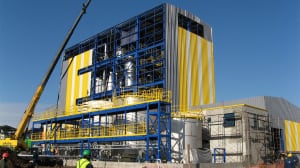Abengoa S.A. (Seville, Spain; www.abengoa.com) will use a zero-liquid-discharge (ZLD) wastewater-treatment plant provded by GEA Group AG (Düsseldorf, Germany; www.gea.com for a power plant in Ciudad Juárez, Mexico. The ZLD plant will convert a salt-laden wastewater stream into pure water for internal recycling and dry solids for disposal.
The ZLD plant will treat brine from a reverse osmosis (RO) plant used to purify different wastewater streams collected within the power plant. The RO plant yields a waste stream containing mainly sodium chloride and sodium sulfate, plus nitrates and carbonates. For this project GEA is supplying a forced-circulation crystallizer followed by a decanter centrifuge for final dewatering. To overcome the boiling point elevation created by the dissolved salts, the crystallizer will use three high speed fans in series as mechanical vapor recompression (MVR) which is heating the system by using electrical energy only.
The forced-circulation crystallizer is a relatively simple solution that is nevertheless flexible and robust enough to handle the varying flows and salt concentrations it is likely to meet in practice, says Robert Buchfink of GEA’s sales support team. Together with the decanter, it provides a solution for facilities that wish to avoid discharging wastewater containing salts. Larger ZLD plants would normally add a pre-concentration stage upstream of the crystallizer. ZLD is increasingly attractive in areas where water is scarce and in environmentally sensitive regions where it is not possible to discharge contaminated water. GEA ZLD systems are based around membrane separation, evaporation, crystallization, drying and energy recovery.
